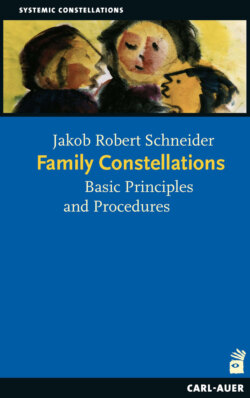Читать книгу Family Constellations - Jakob R Schneider - Страница 9
На сайте Литреса книга снята с продажи.
Constellations
ОглавлениеThe basic procedures for doing a constellation are actually very simple. In the context of a therapy or personal development group, clients are asked to choose representatives for those people who are important to their issue, including a representative for themselves, and to place them in a spatial relationship to one another. These may be members of the person’s family of origin, which could include the client, siblings and parents, or perhaps only the person’s parents and the client. Sometimes a constellation represents only the client and some symptom of distress. The client chooses the representatives from the people present in the group and, without any comment, positions them within the working space. The person should do this according to a feeling, or some inner sense of what is right, without regard to any reasons for this placement and without consideration of any particular time or any images of historical “scenes” from their family life. The person simply keeps an open heart and follows whatever inner impulse might arise. Normally, it needs to be clear who is representing which person or abstraction (abstractions might include a symptom such as anxiety, or an abstract concept such as “the secret” or “death”).
The therapist may ask the client for information about the family history before the beginning of the constellation in order to get a feeling for the “weight” of the elements and to determine which family members should be included in the constellation from the start. The less the representatives know about the facts, the more convincing their feeling responses, but a constellation usually receives the initial impulse from some essential information. Surprisingly, experience has shown that the course of the constellation is more influenced by the feelings and sensory awareness of the representatives than by the information provided by the client or the therapist’s initial conjectures.
When the representatives have been positioned, the client sits down again and watches from outside the working area. After a brief pause to allow everyone to collect themselves, the therapist asks the representatives to report what they are feeling, or any physical symptoms they might be aware of. They may be asked to respond verbally or with a physical expression of some impulse or movement, or with some combination of the two.
In this process, the wisdom of the client’s soul and the “soul” of the family can be seen, felt and experienced through its effects and influence. This experience is available to the client, the therapist, and everyone in the group. The key factor is whether the movements of the representatives, independent or prompted by the therapist, reveal the dynamics operating in the family’s soul and eventually ease the difficulties and lead to an image of resolution. If this process of uncovering dynamics and moving towards resolution begins to stagnate, the therapist has to intervene. Additional representatives for other family members might be included, referring back to the information provided earlier by the client. For example, the therapist might decide to include the client’s grandparents, or a one-time fiancée of the client’s father, or might ask the client for additional information and change the composition of the constellation accordingly. New characters may be added, such as a deceased aunt who had once been in a psychiatric hospital.
The constellation comes to rest when the members of the client’s family have moved from their fateful dynamics to find their way to each other with love and respect, when excluded family members have been re-integrated, and when each member of the family has found an appropriate place.
When the dynamics and the path to resolution are clear, the client is often put into the constellation in place of his or her representative, to experience the ease of standing in a good place in a reconciled or newly organised system. In addition to the movements of the representative that point towards the future, resolutions often demand some kind of ritual. This may include bowing down in respect and acknowledgement or brief communications between particular family members, or between the client and others in the family, especially his or her parents. Such rituals allow the soul to move in the direction of a good resolution, but the spoken words also make very clear to the client what it is that binds him or her to the system and what can bring about resolution.
